Der FC St. Pauli verliert gegen den VfL Bochum. Und das verdient. Denn obwohl Bochum genauso gespielt hat, wie es zu erwarten war, konnte der FCSP nur eine Halbzeit lang mithalten. Ähnlich wie im Hinspiel fokussierte sich der FCSP auf das Umschaltspiel, während Bochum den Ballbesitz suchte – und letzlich erfolgreich fand. Die Niederlage ist vor allem deswegen ärgerlich, da die Art und Weise der Gegentore einmal mehr die eigenen Schwächen offenlegte.
Das Highlight des gestrigen Abends, im wahrsten Sinne des Wortes, gab es vor dem Spiel zu bestaunen (siehe Titelbild). Ich selbst war gerade mit den Aufbauten für das AFM-Radio beschäftigt, als an der Budapester Straße ein Feuerwerk losging, das an Schönheit wohl kaum zu überbieten ist. Der Team-Bus des FCSP wurde von Feuerwerkskörpern und unzähligen Bengalos empfangen. Ein tolles Bild (welches durch die Scheibe von der Gegengerade leider nicht ansatzweise so schön aussieht, wie es wirklich war). Was für ein Push! Entsprechend startete das Spiel dann ja auch. Wahnsinn (und hier aus einer anderen Perpektive).
Die Aufstellung
Tja, da ging es eigentlich schon los mit den Problemen. Denn Sebastian Ohlsson fiel mit „muskulären Problemen“ kurzfristig aus. Ich hoffe sehr, dass es sich auch nur um eine kurzfristige Verletzungsdauer handelt, denn einmal mehr wurde deutlich, dass er auf der rechten Außenvertediger-Position nur schwer zu ersetzen ist. Der FCSP startete also leicht verändert mit Adam Dźwigała als Rechtsverteidiger.
Der VfL Bochum begann ebenfalls nur auf einer Position verändert: Gerrit Holtmann durfte anstelle von Pantovic von Beginn an auf der Außenbahn ran. Die beiden neuen Spieler in der Startelf stellten dann auch das größte Mismatch des Spiels dar.
Spielkontrolle vs. Umschalten
Im Vorbericht hatte ich darauf hingewiesen, dass für den FCSP die offensiven Umschaltmomente von zentraler Bedeutung werden würden. Und es war auch ziemlich schnell erkennbar, dass der FCSP genau darauf seinen Fokus gelegt hatte. Nachdem die erste vielversprechende Situation noch von Omar Marmosuh recht leichtfertig vertändelt wurde, machte es der FC St. Pauli in der 4.Minute besser: Kyereh agierte, wie in der gesamten ersten Halbzeit gedankenschnell und verlagerte nach dem Gewinn des 2.Balles auf Paqarada der den Ball zentral vor das Tor brachte. Dort spielte Guido Burgstaller dann einen Doppelpass mit der Latte – 1:0 (das er überhaupt erst einen Doppelpass mit der Latte spielte, egal – drin das Ding). Ein perfekter Start!
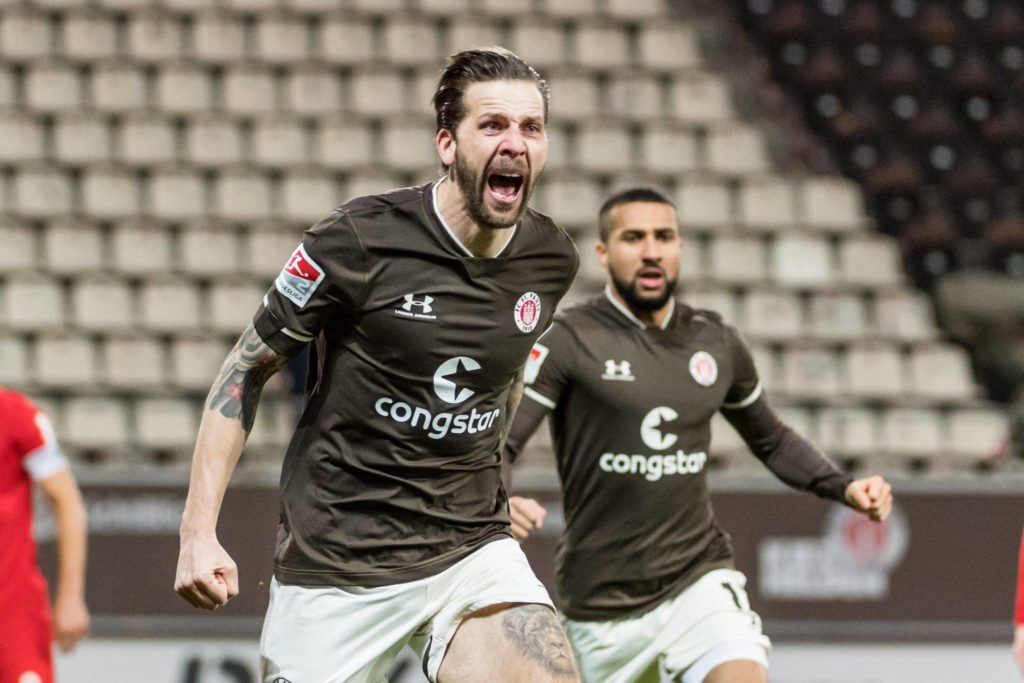
Nach vier Minuten bereits einen Doppelpass mit der Latte gespielt haben und 1-0 in Führung liegen? Guido kann es!
(imago images/via OneFootball)
Doch die Führung sollte nichts daran ändern, dass der VfL Bochum eine unglaublich reife Spielanlage am Millerntor präsentierte und diese Stück für Stück und mehr und mehr durchsetzte. Der FCSP konnte zwar immer mal wieder nach Ballgewinnen umschalten und das war meist auch immer gleich vielversprechend, da die Stellung vom VfL Bochum ziemlich offen war bei Ballverlusten. Aber der FCSP schloss diese Situation zu selten mit Torschüssen ab.
Stattdessen müssen wir uns zwangsläufig dem, zugegeben, sehr schönen Ballbesitzfußball von Bochum widmen:
Ebenfalls im Vorbericht hatte ich auf Manuel Riemann hingewiesen, der bis zu diesem Spieltag mehr Pässe gespielt hat als ein Großteil der FCSP-Feldspieler (nur vier hatten mehr). Bei Ballbesitz rückte Riemann meist gute 20-25 Meter aus seinem Tor heraus. Dadurch konnten die beiden Innenverteidiger Leitsch und Bella-Kotchap nach außen schieben (es war also keine „fallende Sechs“ sondern eine „aufrückende Eins“). Diese Bewegung löste eine Kettenreaktion im Aufbauspiel der Bochumer aus. Denn die beiden Außenverteidiger Soares und Gamboa, zwei technisch richtig starke Spieler, konnten dadurch weit nach vorne schieben und drückten ihrerseits die offensiven Außen noch weiter nach vorne in die letzte Reihe.
Etwas Absicherung der damit doch recht offenen Stellung bot Sechser Anthony Losilla, der im Vergleich zum gestern richtig starken Tesche eher defensiv agierte. Tesche hingegen schob immer wieder vorne mit rein, bildete dabei vornehmlich Dreiecke mit den beiden linken Außenspielern. Das tat auch Robert Žulj sehr gerne, der immer wieder von seiner zentralen Position auf die Seiten auswich (vornehmlich auf die linke Seite) und dort ein guter Verbindungsspieler war.
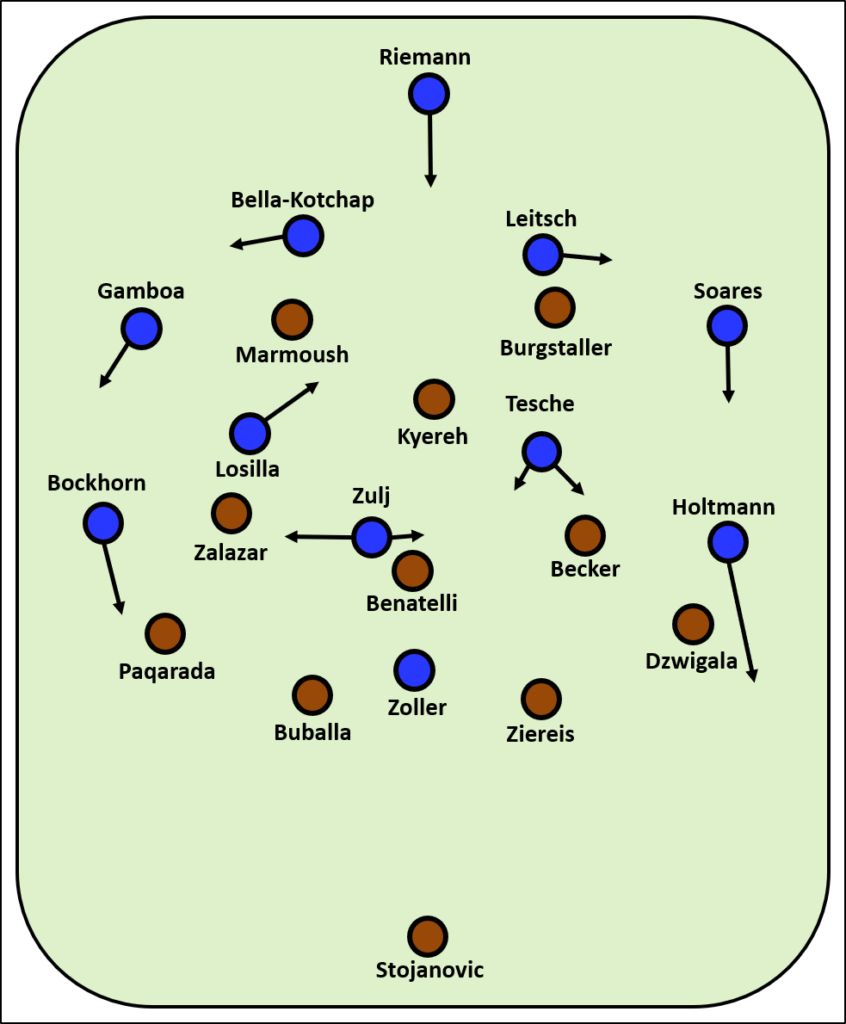
Der Druck der Bochumer wurde dann auch ziemlich schnell ziemlich groß. Und das war in der ersten Halbzeit häufig deshalb, da Gerrit Holtmann (aber auch Herbert Bockhorn, wenn sie denn die Seiten tauschten) gegen Adam Dźwigała massive Geschwindigkeitsvorteile hatten. Auch hier verweise ich wieder auf den Vorbericht, der Holtmann als den Spieler hervorhob, der enorm viel dribbelt und flankt. Am Ende des Spiels standen acht Flanken in Holtmanns Arbeitsnachweis (der Schnitt der Top3 der Liga liegt bei sieben) und 12 Dribblings (weit über seinem Schnitt und damit ebenfall in den Top3) von denen er sehr gute sieben gewann.
Sind wir mal ganz ehrlich: Adam Dźwigała hatte nicht den Hauch einer Chance gegen Gerrit Holtmann (und hat das dafür noch ganz gut gemacht). Konnte er auch gar nicht, da er überhaupt nicht die Geschwindigkeit und Beweglichkeit hat, die Holtmann als offensiver Außen auf die Platte bringt. Muss er auch gar nicht, denn er ist ja Innenverteidiger und kein Rechtsverteidiger. Das ist gegen Kiel gutgegangen, da Fin Bartels sehr gerne in die Mitte driftet und auch nicht das Tempo von Holtmann hat. Dźwigała vs. Holtmann war jedoch ein ziemlich klares Mismatch, welches der VfL Bochum zielsicher bespielte. Folgerichtig wurde Luca Zander in der Halbzeit für Dźwigała eingewechselt.
Zehn Sekunden traumhaft – leider auf der falschen Seite
Der Ausgleich des VfL Bochum deutete sich dann auch durchaus an: Nach einigen Chancen zeigten die Bochumer einmal kurz, was für eine Wahnsinnsachse sie in der Zentrale sie haben: Der Abwurf von Riemann überspielt die erste Kette – Tesche verarbeitet gut und überspielt die zweite Kette – Zulj macht eine Drehung und spielt einen Pass bei dem Richtung, Tempo, und Länge, bei dem einfach alles passt, den Tom Brady nicht besser hätte werfen können (da ist mir echt der Mund offengeblieben, Alter, was war das denn?!) und überspielt damit die letzte Kette – Simon Zoller tunnelt Stojanović und schiebt locker ein. Ich muss es einfach sagen: Ein tolles Tor! Zumal zwischen Abwurf Riemann und Torschuss Zoller nicht einmal zehn Sekunden liegen.
Aber es war trotzdem vermeidbar: Denn wenn Dejan Stojanović sein Tor verlässt um in einen Zweikampf mit Simon Zoller zu gehen, dann muss er diesen Zweikampf auch führen und sich im Zweifel einfach flach vor den Ball werfen, zum Lupfen wäre Zoller nicht mehr gekommen. Klar, die Geschwindigkeit war enorm hoch und wenn er nicht aus dem Tor kommt, dann ist es trotzdem eine dicke Chance für Bochum. So sah es aber schon richtig unglücklich aus.
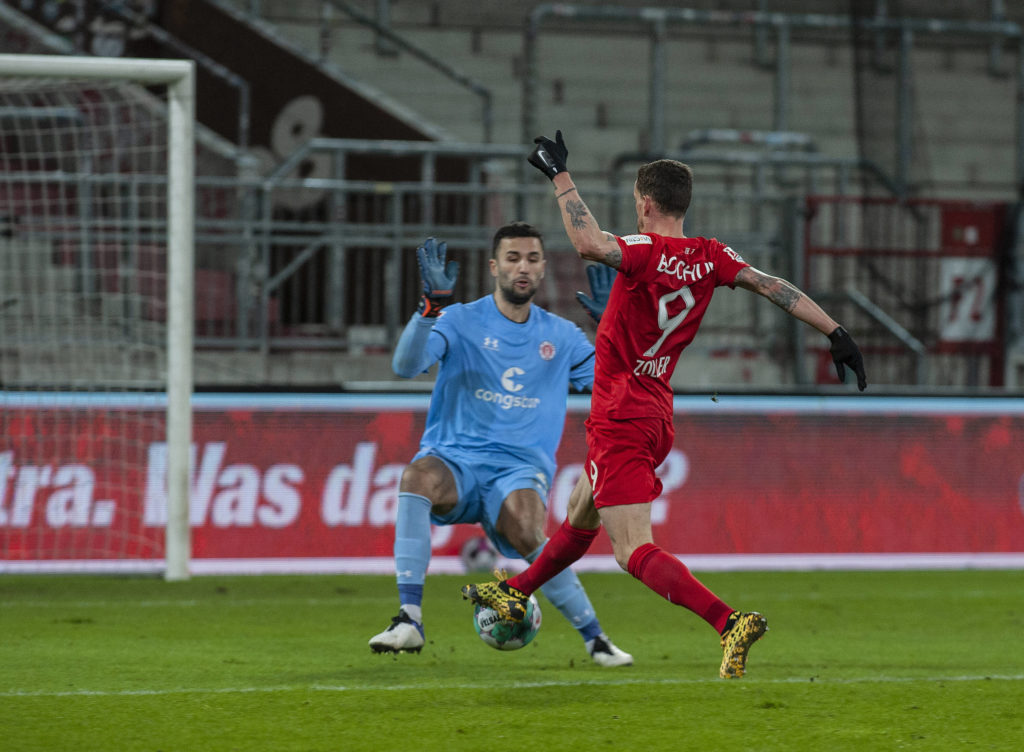
(imago images/via OneFootball)
Ein ärgerliches Gegentor. Trotzdem war der Spielverlauf vorhersehbar und eigentlich ging der Plan des FCSP auf: Der VfL Bochum bestimmte das Spiel und der FCSP lauerte auf seine Umschaltmomente. Von denen ergaben sich in der ersten Halbzeit viele, sehr viele. Aber der FCSP machte viel zu häufig zu wenig daraus, konnte diese, ich wiederhole mich, nur ganz selten mit einem Torabschluss beenden (sinnbildlich dafür ein Konter, den Marmoush mit einem Pass auf Burgstaller wohl zum 2-0 hätte veredeln können, aber den entscheidenden letzten Pass nicht spielte).
Trotzdem stand es nur kurze Zeit nach dem Ausgleich 2-1. Weil Daniel-Kofi Kyereh dem Ball dank Unebenheiten im Rasen eine ganz krumme Drehung verpasste und Manuel Riemann nicht wirklich optimal bei seinem Schuss aus rund 22 Metern aussah.
Was wäre es wohl für ein Spiel geworden, wenn der FC St. Pauli mit dieser Führung in die Halbzeit gegangen wäre? Schwer zu beantworten. Muss ich aber auch nicht, da Gerrit Holtmann von seinen acht Flanken eine einzige an den Mitspieler brachte – die zum 2-2. Und auch hier müssen sich der FCSP wieder an die eigene Nase fassen: Philipp Ziereis hätte den Ball easypeasy rausköpfen können, aber sagte nach dem Spiel zu der Situation „Dejan ruft und ich ziehe meinen Kopf leider weg„. Kagge.
Die 2.Bälle für den FCSP sind in der Kabine geblieben
Denn obwohl mit der Einwechslung von Luca Zander zumindest das Mismatch auf der rechten Außenbahn beendet werden konnte, spielte in der 2.Halbzeit nur noch der VfL Bochum. Es gab kaum mehr Entlastung für den FC St. Pauli. Es schien als wenn die offensive Dreierreihe um Kyereh, Burgstaller und Marmoush völlig abgeschnitten wurde. Besonders Marmoush gelang ziemlich wenig: Er gewann nur 2 von 11 Duellen in der Offensive).
Und bei drei Gegentoren schauen wir uns natürlich auch die Quoten der FCSP-Innenverteidiger an: Philipp Ziereis gewinnt 53% seiner Zweikämpfe und 50% seiner Kopfballduelle, Daniel Buballa gewinnt 50% seiner Zweikämpfe und keines seiner Kofpballduelle. Zum Verlgeich ein Blick auf die Gegenseite: Maxim Leitsch gewinnt alle seine Kopfballduelle und bockstarke 86% seiner Zweikämpfe und Bella-Kotchap liegt mit seinen Werten etwas besser als Ziereis. Diese Statistiken wären nicht nötig gewesen, es ist auch so allen klar: Die Innenverteidigung fiel gestern wieder in alte Muster zurück – ein Déjà-vu.
Ich kann ehrlich nicht genau sagen, was sich zwischen den Halbzeiten im Spiel geändert hat, ich habe keine Umstellung der Bochumer erkannt. Nur waren die zweiten Bälle gefühlt wesentlich häufiger bei Bochum als beim FCSP. Das macht das eigene Spiel natürlich mürbe, wenn Du ständig hinterherlaufen musst. Auffällig war jedoch, dass der VfL Bochum in der zweiten Halbzeit sehr viel mehr Situationen direkt durch das Zentrum erspielen konnte, was aus meiner Sicht daran lag, dass Robert Tesche ein wenig offensiver agierte und damit den Druck auf Benatelli, Becker und Zalazar enorm erhöhte.
Es kam allerdings auch kein richtiger Impuls mehr, keine Initialzündung oder eine Art Aufbäumen gegen stark spielende Bochumer. Stattdessen wurde das Spiel mit jeder weiteren Minute einseitiger. Das dritte Tor des VfL Bochum ist dann wieder klasse herausgespielt, aber eben auch recht pomadig verteidigt und als abgefälschter Schuss dann letzlich auch einfach ein Kack-Tor.

(imago images/via OneFootball)
Ein paar Statistiken zu Simon Zoller: Der hat gestern für einen Stürmer unglaubliche 75% seiner Zweikämpfe (80% in Offensivzweikämpfen), alle seine Kopfballduelle und alle seine Dribblings gewonnen (passt recht gut mit den oben genannten stats der FCSPIV zusammen). Gerade im Pressing der Bochumer genügte es häufig schon, wenn Zoller alleine Buballa, Stojanovic und Ziereis anlief, um den langen Ball zu forcieren. Ein 3-gegen1 was letztlich klar an die 1 ging. Beeindruckende Lesitung auf Bochumer Seite.
Ebenfalls kam es, wie im Vorbericht erwartet: Robert Zulj (1 Tor, 1 Vorlage) und Simon Zoller (2 Tore, 1 Vorlage) waren offensiv ganz stark und gestern für den FCSP letztlich eine Nummer zu groß.
Es war schon fast eine Art Déjà-vu: Auch im Hinspiel gab es zwei recht unterschiedliche Halbzeiten. In der ersten dominierte der VfL Bochum auch deshalb, weil der FCSP nur selten gut ins Umschalten kam und die Halbräume herschenkte. In der zweiten Halbzeit hatte der FC St. Pauli viele vielversprechende Situationen und der VfL Bochum konnte mit dem vielen Ballbesitz kaum mehr etwas anfangen. Gestern Abend war es dann genau anders herum: Der FCSP hatte vor allem in der ersten Halbzeit vielversprechende Umschaltmomente und brachte in der zweiten kaum mehr was auf die Kette. Zu allem Überfluss legten sie sich die drei Gegentore auch noch alle irgendwie selbst rein. Alles in allem ein Déjà-vu, dass mich an viele schlechte Momente in der bisherigen Saison erinnert.
Bochum war besser – Kurz ärgern, dann in Heidenheim besser sein!
Zweifelsohne hat dieses Spiel gezeigt, dass wir diese Saison mit einigen Teams spielerisch nicht mithalten können. Das war in Fürth so und das war nun auch gegen den VfL Bochum so. Ich würde mir wünschen, dass es anders wäre, aber das ist es momentan einfach nicht, das muss ich leider ganz ehrlich so sagen. Diese Teams sind dem FCSP aktuell in vielen Dingen voraus.
Und dieses Spiel hat auch einmal mehr gezeigt, dass die Defensive des FCSP alles andere als stabil ist. Die Null gegen Regensburg hin oder her, es passt an zu vielen Ecken und Enden nicht. Da fallen immer wieder Gegentore, die passieren können, beim FCSP aber im Verlauf der Saison viel zu häufig passieren, sodass hier nicht mehr von Pech gesprochen werden kann.
Das bedeutet aber natürlich nicht, dass es alles für die Katz ist. Im Gegenteil: Wir sind auch weiterhin auf dem richtigen Weg. Nur führt der eben nicht so steil nach oben, wie wir uns das alle wünschen sondern mit langsamen Schritten aufwärts. Immer weiter vor!
// Tim
Alle Beiträge beim MillernTon sind gratis. Wir freuen uns aber sehr, wenn Du uns unterstützt.
MillernTon auf BlueSky // Mastodon // Facebook // Instagram // Threads // WhatsApp // YouTube
{:}{:en}FC St. Pauli loses against VfL Bochum. And deservedly so. Because although Bochum played exactly as expected, FCSP could only keep up for one half. Similar to the first leg, FCSP focused on transition play, while Bochum looked for possession – and ultimately found it successfully. The defeat is particularly annoying because the manner in which the goals were conceded once again exposed the team’s own weaknesses.
Last night’s highlight, in the truest sense of the word, was to be marvelled at before the match (see cover picture). I myself was busy setting up for AFM radio when a fireworks display went off on Budapester Straße that can hardly be surpassed in beauty. The FCSP team bus was greeted by fireworks and countless flares. A great picture (which unfortunately doesn’t look nearly as beautiful through the glass from the back as it really was). What a push! The game started accordingly. Madness (and here from a different perspective).
Da hüpft das Fanherz ?? pic.twitter.com/0jeeyIWmGz
— Tascha (@TaschaCL) January 28, 2021
The line-up
Well, that’s when the problems really started. Sebastian Ohlsson had to pull out at short notice due to „muscular problems“. I really hope that this was only a short-term injury because once again it became clear that he is difficult to replace as a right wing-back. So FCSP started slightly changed with Adam Dźwigała as a right wing-back.
VfL Bochum also started with only one position changed: Gerrit Holtmann started on the wing instead of Pantovic. The two new players in the starting eleven were the biggest mismatch of the match.
Match control vs. transition
In the pre-match report, I had pointed out that the offensive transition moments would be of central importance for the FCSP. And it was quickly apparent that this was precisely the focus of the FCSP. After the first promising situation had been missed by Omar Marmosuh, FC St. Pauli did better in the 4th minute: Kyereh, as in the whole first half, was quick-witted and, after winning the second ball, shifted to Paqarada who centred the ball in front of the goal. Guido Burgstaller then played a double pass with the crossbar – 1:0 (never mind that he played a double pass with the crossbar in the first place – it was in). A perfect start!

(imago images/via OneFootball)
But the lead should not change the fact that VfL Bochum presented an incredibly mature game at the Millerntor and enforced it bit by bit and more and more. The FCSP was able to transition every now and then after winning the ball and that was usually promising because the positioning of VfL Bochum was quite open when losing the ball. But the FCSP seldom finished these situations with a shot on goal.
Instead, we inevitably have to devote ourselves to Bochum’s, admittedly very beautiful, possession football:
Also in the pre-match report, I had pointed out Manuel Riemann, who until this matchday had played more passes than most of the FCSP field players (only four had more). In possession, Riemann usually moved a good 20-25 metres out of his goal. This allowed the two centre-backs Leitsch and Bella-Kotchap to push outwards (so it was not a „dropping six“ but an „advancing one“). This movement triggered a chain reaction in Bochum’s build-up play. Because the two outside backs Soares and Gamboa, two technically really strong players, could push far forward as a result and in turn pushed the offensive outsiders even further forward into the back row.
The open position was somewhat protected by Bochum’s central defensive midfielder Anthony Losilla, who, compared to Tesche, who was really strong yesterday, acted rather defensively. Tesche, on the other hand, kept pushing forward, mainly forming triangles with the two left-wingers. Robert Žulj also liked to do that, who repeatedly moved from his central position to the sides (mainly to the left) and was a good link-up player there.

The pressure from the Bochum side then became quite great quite quickly. And that was often the case in the first half because Gerrit Holtmann (but also Herbert Bockhorn, when they switched sides) had massive speed advantages against Adam Dźwigała. Again, I refer to the pre-match report, which highlighted Holtmann as the player who dribbles and crosses an enormous amount. At the end of the game, Holtmann’s work record included eight crosses (the average for the division’s top 3 is seven) and 12 dribbles (well above his average and therefore also in the top 3) of which he won a very good seven.
Let’s be honest: Adam Dźwigała didn’t have a chance against Gerrit Holtmann (and did it actually quite well though). He couldn’t have, because he doesn’t have the speed and agility that Holtmann brings to the platter as an offensive winger. And he doesn’t have to, because he is a centre-back and not a wing-back. That worked out well against Kiel because Fin Bartels likes to drift into the middle a lot and doesn’t have Holtmann’s pace either. Dźwigała vs. Holtmann, however, was a pretty clear mismatch, which VfL Bochum played unerringly. Consequently, Luca Zander was substituted for Dźwigała at half-time.
Ten dreamlike seconds – unfortunately on the wrong side
VfL Bochum’s equaliser was then quite imminent: After a few chances, Bochum briefly showed what a great central axis they have: Riemann’s throw-off overran the first line – Tesche processed well and overran the second line – Zulj made a turn and played a pass with direction, speed and length, where everything just fit, which Tom Brady couldn’t have thrown better (my mouth really dropped open, dude, what was that?!) and overran the last line – Simon Zoller tunneled Stojanović and slid in easily. I just have to say it: A great goal! Especially since there are less than ten seconds between Riemann’s clearance and Zoller’s shot on goal.
But it was still avoidable: When Dejan Stojanović leaves his goal to go into a duel with Simon Zoller, he has to fight this duel and, if in doubt, simply throw himself flat in front of the ball. Sure, the speed was enormous and if he doesn’t come out of the goal, it’s still a great chance for Bochum. But it looked really unfortunate like that.

(imago images/via OneFootball)
An annoying goal against. Nevertheless, the course of the game was predictable and FCSP’s plan actually worked: VfL Bochum dominated the game and the FCSP waited for its opportunities to transition. There were many, many of these in the first half. But the FCSP too often did not make enough of them and could, I repeat, only very rarely finish them off with a goal (symbolic of this was a counter-attack that Marmoush could probably have finished off with a pass to Burgstaller to make it 2-0, but did not play the decisive last pass).
Nevertheless, it was 2-1 just a short time after the equaliser, because Daniel-Kofi Kyereh gave the ball a very crooked turn thanks to unevenness in the turf and Manuel Riemann didn’t really look his best when he shot from around 22 metres.
What kind of game would it have been if FC St. Pauli had gone into half-time with that lead? Hard to answer. But I don’t have to, because Gerrit Holtmann got only one of his eight crosses to his teammate – the one for 2-2. And here again, the FCSP have to look at their own nose: Philipp Ziereis could have headed the ball out easy-peasy, but said after the game about the situation „Dejan calls and I pull my head away, unfortunately“. Crap.
The 2nd balls for FCSP remained in the locker room.
Although the substitution of Luca Zander at least ended the mismatch on the right-wing, only VfL Bochum played in the second half. There was hardly any relief for the FC St. Pauli. It seemed as if the offensive front three around Kyereh, Burgstaller and Marmoush was completely cut off. Especially Marmoush managed quite little: he won only 2 of 11 duels in the offensive.
And with three goals conceded, we naturally look at the match data of the FCSP centre-backs: Philipp Ziereis wins 53% of his duels and 50% of his headers, Daniel Buballa wins 50% of his duels and none of his headers. For comparison, take a look at the other side: Maxim Leitsch wins all of his headers and 86% of his duels, and Bella-Kotchap is slightly better than Ziereis. These statistics would not have been necessary, it is clear to everyone: The central defence fell back into old patterns yesterday – a déjà vu.
I honestly can’t say exactly what changed in the match between the halves, I didn’t see any change in the Bochum team. It’s just that the second balls were much more frequent for Bochum than for FCSP. Of course, that wears down your own play when you have to chase constantly. However, it was noticeable that the VfL Bochum was able to create many more situations directly through the centre in the second half, which in my view was due to Robert Tesche acting a little more offensively and thus increasing the pressure on Benatelli, Becker and Zalazar enormously.
However, there was no real impetus either, no initial spark or any kind of rebellion against Bochum, who were playing strongly. Instead, the game became more one-sided with each passing minute. VfL Bochum’s third goal was again well played out, but it was also defended in a rather pompous manner and, as a deflected shot, it was simply a crap goal.

(imago images/via OneFootball)
A few statistics on Simon Zoller: Yesterday, he won an unbelievable 75% of his duels (80% in offensive duels), all of his headers and all of his dribbles for a striker (fits in quite well with the FCSP centre-back’s stats mentioned above). Especially in Bochum’s pressing, it was often enough for Zoller to run into Buballa, Stojanovic and Ziereis alone to force the long ball. A 3-on-1 that ultimately went clearly to the 1. Impressive reading on the Bochum side.
It also happened as expected in the pre-match report: Robert Zulj (1 goal, 1 assist) and Simon Zoller (2 goals, 1 assist) were very strong offensively and were ultimately too big for FCSP yesterday.
It was almost a kind of déjà vu: In the first leg, too, there were two quite different halves. In the first half, VfL Bochum dominated because FC St. Pauli rarely switched gears well and gave away the half-chances. In the second half, FC St. Pauli had many promising situations and VfL Bochum could hardly do anything with all the possession. Last night it was the other way round: FCSP had promising moments of transition play, especially in the first half, and could hardly get anything going in the second. To make matters worse, they somehow managed to score the three goals they conceded themselves. All in all, a déjà vu that reminds me of many bad moments in the season so far.
Bochum was better – Annoy briefly, then be better in Heidenheim!
Without a doubt, this game showed that we can’t keep up with some teams this season. That was the case in Fürth and it was also the case against VfL Bochum. I would like it to be different, but it’s just not the case at the moment, I have to say that quite honestly. These teams are currently ahead of FCSP in many ways.
And this game also showed once again that FCSP’s defence is anything but stable. The zero against Regensburg or not, it doesn’t fit in too many places. There are always goals conceded, which can happen, but happen far too often at FCSP in the course of the season so that one can no longer speak of bad luck here.
But of course, that doesn’t mean that it’s all for nothing. On the contrary, we are still on the right track. It’s just that it doesn’t lead as steeply upwards as we would all like, but rather with slow steps upwards. Keep moving forward!
// Tim (translated by Arne)
MillernTon Twitter //
MillernTon YouTube //
MillernTon Facebook //MillernTon Instagram //
If you like what we do here, here you’ll find the information on how to support us.
{:}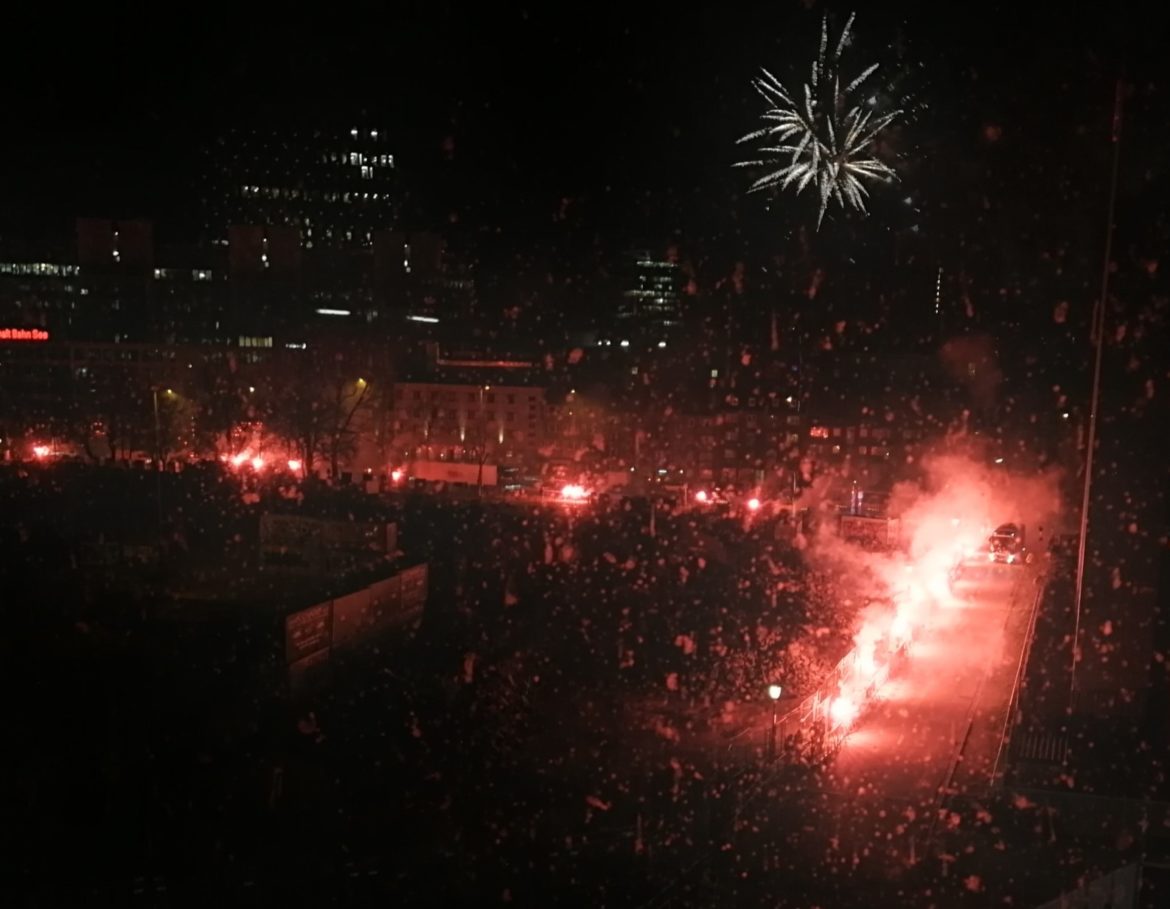

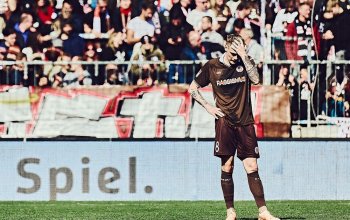
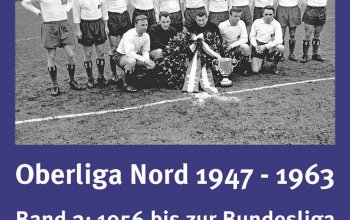

Danke für die sehr gute Analyse. Kleiner Zusatz: Bei aller berechtigten Kritik an der Vereidigungslinie, ich glaube, dass unsere Defensivschwächen im DM beginnen, und dass man da dieser Raute (Benatelli, Zalazar, Becker) durchaus etwas Beachtung in der Betrachtung des Defensivspiels schenken darf. Die letzten 5 Gegentore resultierten allesamt aus einer Passivität (bedingt durch das Stellungsspiel?) der DM. Mal ist es Becker, der nicht in die Zweikämpfe kommt, mal Zalazar, mal Benatelli (1:2 Hannover) mal sogar zwei Spieler (gestern beim 1:1 Zalazar/Benatelli).
Zu der Offensive in der zweiten Halbzeit bliebe zu sagen, dass wir durchaus (zugegeben wenige) Umschaltmomente hatten, wo die Spieler allerdings entweder zu langsam, oder schlicht zu eigensinnig agierten, und wir uns damit möglicher guter Chancen selbst beraubt haben. Auch hier bliebe aber tatsächlich die Frage, wieso die Offensivspieler in der zweiten Halbzeit so wenig in Szene gesetzt werden konnten. Und auch hier käme man nicht daran vorbei, die Besetzung des MF zu diskutieren. Eventuell sind Becker, Zalazar und Benatelli da einfach nicht optimal.
Volle Zustimmung. Gerade im Bereich Defensivzweikämpfe ist es für Becker häufig sehr schwierig. Er macht für seinen körperlichen Nachteil noch richtig gut, aber das geht natürlich viel besser. Der gehört einfach ein Stück weiter nach vorne.
Wie wichtig Lawrence und Smith für das werden…
Kann mich Paul da nur anschließen, was ich in der zweiten Halbzeit vor allem beobachtet habe, war, dass insbesondere vor dem eigenen Sechzehner, also da wo das DM zu erwarten wäre, viel zu viele Räume angeboten wurden und die ballführenden Spieler imho viel zu spät, wenn überhaupt, angelaufen wurden. Und wenn ich einem Spieler mit dem Ball am Fuß dann eben auch noch die entscheidenden Sekunden Zeit gebe, den nächsten Pass ordentlich vorzubereiten, dann muss ich mich auch nicht wundern, wenn so ein Pass dann auch ankommt und daraus eine weitere gefährliche Situation entsteht. Dabei frage ich mich nun aber, ob man dieses konsequentere Anlaufen des ballführenden Spielers in Summe physisch auch wirklich über die gesamte Spielzeit leisten kann.
Danke für die gute Analyse.
Arnd Zeigler wird sich sicherlich gefreut haben. Hat er doch in einem Spiel alle 5 Kandidaten für das Kacktor des Monats zusammen.
Gibt´s auch nicht so oft…
Aber echt!
Ich hatte das Gefühl, dass die offensiven Außen (sowohl Holtmann und Bockhorn-Nachfolger Pantovic, v.a. aber die Außenverteidiger) der Bochumer in der 2.HZ in der Defensivbewegung schneller die Räume enger machten, als auch das leichte Nach-Außen-Schieben der IV der Bochumer dafür sorgten, dass unsere Offensivspieler, so sie überhaupt den Ball verarbeiten konnten, mehr auf Einzelaktionen angewiesen waren.
Dazu war gerade Zulj in HZ 2 immer wieder anspielbar und Holtmann sich statt außen um Dzwigala herum mehr Richtung nachrückenden Zulj/Tesche/Losilla oder den sich fallen lassenden Zoller orientierte, die halt leider sehr gut in genau die von uns nicht vernünftig besetzten Räume vor den IV bewegten.
Und leider habe ich den Eindruck, dass wir keinen echten Abwehrchef haben, also keinen, der mit Übersicht Anweisungen gibt, Zuordnungen oder Räume zuteilt, wenn nötig.
Lustig – mein browser zeigt mir euern guten Artikel auf englisch :), alle Antworten sind deutsch. Ich bin in Hamburg lebender VfL-Fan, und kann die Enttäuschung verstehen. Wie unsere im Hinspiel, als ihr noch das 2:2 geschafft habt. Das war vom VfL ein hervorragendes Spiel, und ihr werdet da unten sehr schnell rauskommen, wenn ihr so spielt, ja, kleine Fehler ( auch vom neuen Torwart; was ist eigentlich mit Himmelmann? Ich traf in Amburgo ab und zu mal Heerwagen, der bei euch und in Bochum gespielt hat). Der VfL hatte eigentlich (Blum verletzt) nur einen schwächeren Spieler, Herbert Bockhorn, der vielseitig ist und viel mehr kann. Seine 2 Schwalben – eindeutige – störten mich allerdings. Wenn wir diese Dauer-Unterbrechungen und Video-Beweis schon – meiner Meinung – ertragen müssen, dann sollten viele gelbe Karten mehr für all diese Schwalben und „ich kann kaum noch laufen, Schiri, aber mein nächster Spring wird so gut wie der eben“ gegeben werden. Vergleicht bitte mal mit dem Frauen-Fußball, das Gejammer kommt da nicht vor.
Zulj ist, wenn gut gelaunt, schwer zu stoppen, obwohl er ja nicht schnell ist. Riemann – er macht öfter solche Tor-Vorbereitungen – ist herausragend, kleine Chancen hättet ihr gehabt, wenn schnelle Leute unsere nicht sooo flinken Losilla (Dauerläufer, enorm wichtig, und was für ein Superkerl), Tesche und eben Zulj öfter hättet überlaufen können.
Das war – und das 3.Tor war abgefälscht und glücklich für Bochum – eins der wirklich besseren Spiele des VfL, und ihr wart gleichwertig. Da kann Würzburg 3 Trainer in der Hinrunde brauchen, und jetzt 6 neue Spieler kaufen – ins Mittelfeld solltet ihr es locker schaffen.
Eure Defensive hatte diesmal wirklich gute Gegner, Holtmann (der nur selbst fast immer verschießtI ist extrem schnell, Zoller war nach einigen nicht so guten Spielen in Top-Form, Zulj machte sein bestes Spiel, seit er beim VfL ist (er saß auch mal auf der Tribüne, ein teils schwieriger Kerl, dem öfter die Lust vergeht; nicht aber, wenn wir aufsteigen^^). Dazu Riemann als Vorbereiter…sowas, gut eingespielt, gibts nicht oft in Liga 2. Noch flüssiger vorne spielt nur Fürth. Der Weg beim nicht reichen VfL war (begünstigt durch Corona, normal gehen sonst immer 2-3 Spieler mehr, und Ganvoula und Blum zogs ja sehr weg) – daß diesmal eine Mannschaft incl. guter Ersatzbank geduldig aufgebaut werden konnte.
Das kapitalistische „3 Trainer rauswerfen pro Saison“ – das gab es in Bochum auch ein einziges Mal – ist widerlich, und hilft auch nie. Es scheint ja immer manischer zu werden, einige Vereine haben den 3. Trainer schon in der Hinrunde (Schalke auch.)
Leider bin ich kein Orakel, aber 10.-12. könntet ihr diese anfangs verkorkste Saison werden, oder? Und nächstes Jahr dann wieder weiter oben.
Vielen Dank für Deinen Kommentar – und den Artikel bieten wir tatsächlich auf Deutsch und Englisch an, Du kannst das oben rechts mit der Länderflagge ändern 🙂
Zu Himmelmann: Der ist inzwischen nicht mehr bei uns unter Vertrag, das gab auch einigen Wirbel.
https://millernton.de/2021/01/13/tschuess-skyman/